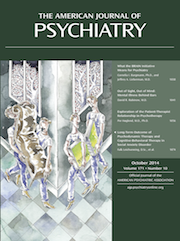To the Editor: We thank Drs. Daniel M. Pearlman and Souhel Najjar for their interest in our study. They suggested some additional analyses relevant to the relationship between Zif268 and GAD67 mRNA levels in the dorsolateral prefrontal cortex of subjects with schizophrenia, which we provide below. First, the significant positive association we reported between Zif268 and GAD67 mRNA levels in schizophrenia subjects by Pearson’s correlation (r=0.29, p=0.027) is supported by the requested Spearman’s correlation (r=0.33, p=0.013) in the same schizophrenia subjects.
Second, Pearlman and Najjar suggest looking for the association between Zif268 and GAD67 mRNA levels just within the schizophrenia subjects who had Zif268 mRNA levels lower than their matched comparison subject. We do not think such an analysis is informative because it imputes biological meaning to findings of uncertain significance (e.g., Is a 5% difference within a one subject pair really different from a 5% difference in the opposite direction in another subject pair?). Indeed, as indicated in the Methods section, we used subject pairing to control experimental variance and to reduce biological variance across groups and not a true paired design in which the only difference between subjects in a pair is the independent measure of interest. Thus, the arbitrary exclusion of some subjects with schizophrenia based on pairwise differences would reduce statistical power without a biological or statistical rationale. However, as we reported in the article, the use of benzodiazepines or sodium valproate at the time of death was associated with lower Zif268 mRNA expression, although those subjects with schizophrenia not taking benzodiazepines or sodium valproate at the time of death still had lower Zif268 mRNA levels. Within those schizophrenia subjects, levels of Zif268 and GAD67 mRNAs were strongly correlated (Pearson’s r=0.37, p=0.030), suggesting that eliminating other sources of variance makes the potential causal role of Zif268 in regulating GAD67 expression more evident.
Third, as described in the article, outliers were determined as follows: within each subject group, subjects with Zif268 mRNA levels more than 3 standard deviations from the group mean were considered outliers. Using this criterion, five (four schizophrenia subjects and one comparison subject) of 124 subjects were identified as outliers for Zif268 mRNA levels. Although the inclusion of such subjects is likely only to increase experimental variance, Zif268 and GAD67 mRNA levels were still significantly correlated (r=0.29, p=0.023) across all schizophrenia subjects examined (N=62). Fourth, the subjects included in this study are from well-characterized cohorts that have been previously used in multiple studies. Selection criteria in creating the cohorts involve the measures of tissue quality described in the Methods section and the criteria (age, postmortem interval, etc.) that are used to identify cases appropriate for brain donation. Our approach to the important design issues for case inclusion in postmortem studies has been previously described (
1,
2).
Finally, Pearlman and Najjar note that we acknowledged that factors other than Zif268 may influence GAD67 mRNA expression, and they suggest that inflammation might be one such mechanism. We agree that the neuroinflammatory model of schizophrenia pathogenesis is important to consider. For example, interferon-induced transmembrane protein was reported to be higher in the dorsolateral prefrontal cortex in subjects with schizophrenia, and levels of interferon-induced transmembrane protein and GAD67 mRNAs were negatively correlated in these subjects (
3). As noted in our article, our goal was to explore the proximal molecular mediators that could contribute to lower GAD67 mRNA expression in schizophrenia. Thus, because Zif268 directly binds to the promoter region of the GAD67 gene and is expressed in response to neuronal activation, including activation induced by a number of noxious stimuli, it is possible that neuroinflammation could be upstream of lower Zif268 and/or GAD67 mRNA levels in schizophrenia.

